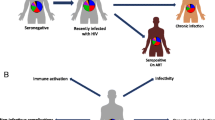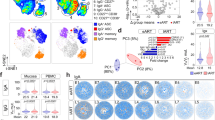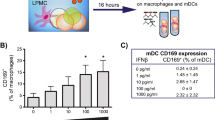Abstract
The gut and its gut-associated lymphoid tissue serve as a preferential site for HIV1 entry, active viral replication, reservoir, and HIV-mediated CD4 cell apoptosis. The widespread use of highly active antiretroviral therapy (HAART) has resulted in a significant decrease in the incidence of opportunistic enteric pathogens as a consequence of immune recovery. Nonetheless, patients with advanced HIV1 disease who were recently diagnosed or have poor response to HAART can still suffer from opportunistic infections with pathogens such as Cryptosporidium, microsporidia, Isospora belli, Cyclospora cayetanensis, Mycobacterium avium complex, and cytomegalovirus, among others. This review describes the impact of HIV1 infection on gut immune function, the salient features of the most common opportunistic enteric pathogens and HIV-associated enteropathy, and the effects of immune reconstitution after introduction of HAART.
Similar content being viewed by others
References and Recommended Reading
Cerf-Bensussan N, Guy-Grand D: Intestinal intraepithelial lymphocytes. Gastroenterol Clin North Am 1991, 20:549–576.
Kotler DP, Reka S, Borcich A, et al.: Detection, localization, and quantitation of HIV-associated antigens in intestinal biopsies from patients with HIV. Am J Pathol 1991, 139:823–830.
Di Stefano M, Favia A, Monno L, et al.: Intracellular and cell-free (infectious) HIV-1 in rectal mucosa. J Med Virol 2001, 65:637–643. This study has important implications in the transmission of HIV1 because HIV RNA and proviral HIV DNA were detected in the intestinal mucosa in a high proportion of patients, even if they had low levels of plasma viremia. The authors also found different phenotypes in the intestinal mucosa with respect to blood, suggesting a different viral evolution in the gut in comparison.
Zhang L, He T, Talal A, et al.: In vivo distribution of the human immunodeficiency virus/simian immunodeficiency virus coreceptors: CXCR4, CCR3, and CCR5. J Virol 1998, 72:5035–5045.
Jarry A, Cortez A, Rene E, et al.: Infected cells and immune cells in the gastrointestinal tract of AIDS patients: an immunohistochemical study of 127 cases. Histopathology 1990, 16:133–140.
Schneider T, Jahn HU, Schmidt W, et al.: Loss of CD4 T lymphocytes in patients infected with human immunodeficiency virus type 1 is more pronounced in the duodenal mucosa than in the peripheral blood. Berlin Diarrhea/Wasting Syndrome Study Group. Gut 1995, 37:524–529.
Schrappe-Bacher M, Salzberger B, Fatkenheuer G, et al.: T-lymphocyte subsets in the duodenal lamina propria of patients infected with the human immunodeficiency virus type 1 and influence of high-dose immunoglobulin therapy. J Acquir Immune Defic Syndr 1990, 3:238–243.
Veazey RS, DeMaria M, Chalifoux LV, et al.: Gastrointestinal tract as a major site of CD4+ T cell depletion and viral replication in SIV infection. Science 1998, 280:427–431.
Kotler DP: Characterization of intestinal disease associated with human immunodeficiency virus infection and response to antiretroviral therapy. J Infect Dis 1999, 179(suppl 3):S454-S456.
Reka S, Garro ML, Kotler DP: Variation in the expression of human immunodeficiency virus RNA and cytokine mRNA in rectal mucosa during the progression of infection. Lymphokine Cytokine Res 1994, 13:391–398.
Mellors JW, Griffith BP, Ortiz MA, et al.: Tumor necrosis factor-alpha/cachectin enhances human immunodeficiency virus type 1 replication in primary macrophages. J Infect Dis 1991, 163:78–82.
Ullrich R, Schieferdecker HL, Ziegler K, et al.: Gamma delta T cells in the human intestine express surface markers of activation and are preferentially located in the epithelium. Cell Immunol 1990, 128:619–627.
Miao YM, Hayes PJ, Gotch FM, et al.: Elevated mucosal addressin cell adhesion molecule-1 expression in acquired immunodeficiency syndrome is maintained during antiretroviral therapy by intestinal pathogens and coincides with increased duodenal CD4 T cell densities. J Infect Dis 2002, 185:1043–1050. Interesting study suggesting that an increased expression of mucosal addressin cell adhesion molecule-1 in lamina propria of HIV1- infected patients is a mechanism for lymphocyte migration to the gut and subsequent destruction, a process that might be inhibited by the use of HAART if no intestinal pathogen were present.
Kaslow RA, Phair JP, Friedman HB, et al.: Infection with the human immunodeficiency virus: clinical manifestations and their relationship to immune deficiency: a report from the Multicenter AIDS Cohort Study. Ann Intern Med 1987, 107:474–480.
Weber R, Ledergerber B, Zbinden R, et al.: Enteric infections and diarrhea in human im-munodeficiency virus-infected persons: prospective community-based cohort study. Swiss HIV Cohort Study. Arch Intern Med 1999, 159:1473–1480.
Fichtenbaum CJ, Zackin R, Feinberg J, et al.: Rifabutin but not clarithromycin prevents cryptosporidiosis in persons with advanced HIV infection. AIDS 2000, 14:2889–2893.
Blanshard C, Francis N, Gazzard BG: Investigation of chronic diarrhoea in acquired immunodeficiency syndrome: a prospective study of 155 patients. Gut 1996, 39:824–832.
Lopez-Velez R, Tarazona R, Garcia Camacho A, et al.: Intestinal and extraintestinal cryptosporidiosis in AIDS patients. Eur J Clin Microbiol Infect Dis 1995, 14:677–681.
Kotler DP, Francisco A, Clayton F, et al.: Small intestinal injury and parasitic diseases in AIDS. Ann Intern Med 1990, 113:444–449.
Hunter PR, Nichols G: Epidemiology and clinical features of Cryptosporidium infection in immunocompromised patients. Clin Microbiol Rev 2002, 15:145–154. This is a comprehensive review of the epidemiologic and clinical features of cryptosporidiosis in HIV1-infected patients, as well as in other immunocompromised populations.
Tzipori S, Griffiths JK: Natural history and biology of Cryptosporidium parvum. Adv Parasitol 1998, 40:5–36.
Flanigan T, Whalen C, Turner J, et al.: Cryptosporidium infection and CD4 counts. Ann Intern Med 1992, 116:840–842.
Chen XM, Keithly JS, Paya CV, et al.: Cryptosporidiosis. N Engl J Med 2002, 346:1723–1731. This is the most recent review on cryptosporidiosis, with emphasis on the pathophysiologic and clinical aspects of the disease.
Sterling CR, Ortega YR: Cyclospora: an enigma worth unraveling. Emerg Infect Dis 1999, 5:48–53.
DeHovitz JA, Pape JW, Boncy M, et al.: Clinical manifestations and therapy of Isospora belli infection in patients with the acquired immunodeficiency syndrome. N Engl J Med 1986, 315:87–90.
Verdier RI, Fitzgerald DW, Johnson WD Jr, et al.: Trimethoprimsulfamethoxazole compared with ciprofloxacin for treatment and prophylaxis of Isospora belli and Cyclospora cayetanensis infection in HIV-infected patients: a randomized, controlled trial. Ann Intern Med 2000, 132:885–888.
Didier ES: Microsporidiosis. Clin Infect Dis 1998, 27:1–8.
Tumbarello M, Tacconelli E, Leone F, et al.: Clostridium difficile-associated diarrhoea in patients with human immunodeficiency virus infection: a case-control study. Eur J Gastroenterol Hepatol 1995, 7:259–263.
Hohmann EL: Nontyphoidal salmonellosis. Clin Infect Dis 2001, 32:263–269.
Mathewson JJ, Jiang ZD, Zumla A, et al.: HEp-2 cell-adherent Escherichia coli in patients with human immunodeficiency virus-associated diarrhea. J Infect Dis 1995, 171:1636–1639.
Polotsky Y, Nataro JP, Kotler D, et al.: HEp-2 cell adherence patterns, serotyping, and DNA analysis of Escherichia coli isolates from eight patients with AIDS and chronic diarrhea. J Clin Microbiol 1997, 35:1952–1958
Wanke CA, Mayer H, Weber R, et al.: Enteroaggregative Escherichia coli as a potential cause of diarrheal disease in adults infected with human immunodeficiency virus. J Infect Dis 1998, 178:185–190.
Clayton F, Kotler DP, Kuwada SK, et al.: Gp120-induced Bob/ GPR15 activation: a possible cause of human immunodeficiency virus enteropathy. Am J Pathol 2001, 159:1933–1939. This interesting study suggests a novel mechanism by which HIV1 induces diarrhea. This mechanism might be related to the activation of a coreceptor through the HIV-Gp120 on the intestinal cells.
Bini EJ, Weinshel EH, Gamagaris Z: Comparison of duodenal with jejunal biopsy and aspirate in chronic human immunodeficiency virus-related diarrhea. Am J Gastroenterol 1998, 93:1837–1840.
Palella FJ Jr, Delaney KM, Moorman AC, et al.: Declining morbidity and mortality among patients with advanced human immunodeficiency virus infection. HIV Outpatient Study Investigators. N Engl J Med 1998, 338:853–860.
Call SA, Heudebert G, Saag M, et al.: The changing etiology of chronic diarrhea in HIV-infected patients with CD4 cell counts less than 200 cells/mm3. Am J Gastroenterol 2000, 95:3142–3146.
Monkemuller KE, Call SA, Lazenby AJ, et al.: Declining prevalence of opportunistic gastrointestinal disease in the era of combination antiretroviral therapy. Am J Gastroenterol 2000, 95:457–462.
Ives NJ, Gazzard BG, Easterbrook PJ: The changing pattern of AIDS-defining illnesses with the introduction of highly active antiretroviral therapy (HAART) in a London clinic. J Infect 2001, 42:134–139. This important retrospective cohort study in an outpatient clinic in London showed a significant 60% decrease in the incidence of cryptosporidiosis, among other infections such as Pneumocystis carinii pneumonia and Kaposi’s sarcoma, after the introduction of HAART.
Kim LS, Hadley WK, Stansell J, et al.: Declining prevalence of cryptosporidiosis in San Francisco. Clin Infect Dis 1998, 27:655–656.
Conteas CN, Berlin OG, Lariviere MJ, et al.: Examination of the prevalence and seasonal variation of intestinal microsporidiosis in the stools of persons with chronic diarrhea and human immunodeficiency virus infection. Am J Trop Med Hyg 1998, 58:559–561.
Bini EJ, Cohen J: Impact of protease inhibitors on the outcome of human immunodeficiency virus-infected patients with chronic diarrhea. Am J Gastroenterol 1999, 94:3553–3559.
Miao YM, Awad-El-Kariem FM, Franzen C, et al.: Eradication of cryptosporidia and microsporidia following successful antiretroviral therapy. J Acquir Immune Defic Syndr 2000, 25:124–129.
Schmidt W, Wahnschaffe U, Schafer M, et al.: Rapid increase of mucosal CD4 T cells followed by clearance of intestinal cryptosporidiosis in an AIDS patient receiving highly active antiretroviral therapy. Gastroenterology 2001, 120:984–987. This is an important report of an AIDS patient with cryptosporidiosis who was started on HAART. The rapid intestinal immune reconstitution observed was associated with the clearance of intestinal parasites.
Conteas CN, Berlin OG, Speck CE, et al.: Modification of the clinical course of intestinal microsporidiosis in acquired immunodeficiency syndrome patients by immune status and anti-human immunodeficiency virus therapy. Am J Trop Med Hyg 1998, 58:555–558.
Sherman DS, Fish DN: Management of protease inhibitorassociated diarrhea. Clin Infect Dis 2000, 30:908–914. This is a relevant review focused on the management of PI-associated diarrhea, including an analysis of the efficacy, cost, and effect on lifestyle of the different therapeutic options.
Kotler DP, Shimada T, Snow G, et al.: Effect of combination antiretroviral therapy upon rectal mucosal HIV RNA burden and mononuclear cell apoptosis. AIDS 1998, 12:597–604.
Talal AH, Monard S, Vesanen M, et al.: Virologic and immunologic effect of antiretroviral therapy on HIV-1 in gut-associated lymphoid tissue. J Acquir Immune Defic Syndr 2001, 26:1–7.
Lampinen TM, Critchlow CW, Kuypers JM, et al.: Association of antiretroviral therapy with detection of HIV-1 RNA and DNA in the anorectal mucosa of homosexual men. AIDS 2000, 14:F69-F75.
Okhuysen PC, Robinson P, Nguyen MT, et al.: Jejunal cytokine response in AIDS patients with chronic cryptosporidiosis and during immune reconstitution. AIDS 2001, 15:802–804.
White AC Jr, Chappell CL, Hayat CS, et al.: Paromomycin for cryptosporidiosis in AIDS: a prospective, double-blind trial. J Infect Dis 1994, 170:419–424.
Doumbo O, Rossignol JF, Pichard E, et al.: Nitazoxanide in the treatment of cryptosporidial diarrhea and other intestinal parasitic infections associated with acquired immuno-deficiency syndrome in tropical Africa. Am J Trop Med Hyg 1997, 56:637–639.
Wilcox CM, Monkemuller KE: Hepatobiliary diseases in patients with AIDS: focus on AIDS cholangiopathy and gallbladder disease. Dig Dis 1998, 16:205–213.
Molina JM, Goguel J, Sarfati C, et al.: Potential efficacy of fumagillin in intestinal microsporidiosis due to Enterocytozoon bieneusi in patients with HIV infection: results of a drug screening study. The French Microsporidiosis Study Group. AIDS 1997, 11:1603–1610.
Author information
Authors and Affiliations
Rights and permissions
About this article
Cite this article
Nannini, E.C., Okhuysen, P.C. HIV1 and the gut in the era of highly active antiretroviral therapy. Curr Gastroenterol Rep 4, 392–398 (2002). https://doi.org/10.1007/s11894-002-0009-z
Issue Date:
DOI: https://doi.org/10.1007/s11894-002-0009-z




